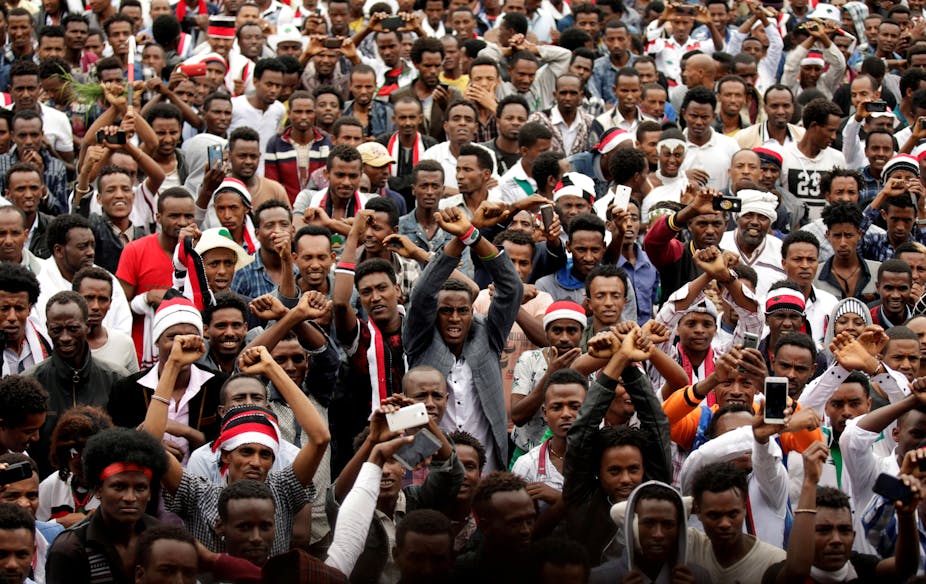The political protests that destabilised Ethiopia’s two largest regional states in 2016 have become a major test for Ethiopia’s ruling People’s Revolutionary Democratic Front.
The protests were triggered by years of accumulated frustration among ethnic groups, particularly the Oromos and Amharas, who say they have been marginalised by the government. The coalition’s response has been to crush them with brute force.
The coalition is made up of four parties: the Oromo Peoples’ Democratic Organization, Amhara National Democratic Movement, Southern Ethiopian People’s Democratic Movement, and the Tigrayan People’s Liberation Front. Strict party discipline during its 26-year rule has helped it survive. But things changed in 2016 when the Oromo People’s Democratic Front and Amhara National Democratic Movement publicly sided with protesters. This led to the Oromo People’s Democratic Organisation emerging as one of the ruling party’s most influential political forces.
By reaching out to the Amhara National Democratic Movement, the Oromo People’s Democratic Organisation seems determined to displace the powerful Tigray Peoples’ Liberation Front from dominating the coalition’s decision making process. It is also hoping to force the ruling coalition to make reforms.
As a result of this political pressure, sharp divisions have begun to emerge within the coalition. This was made clear recently when four coalition luminaries led by Prime Minister Hailemariam Desalegn held a press conference to announce that political prisoners would be released. The announcement raised hopes that Ethiopia was taking a more democratic route. But the regime quickly retracted the statement, claiming that Desalegn had been misunderstood.
A strong opposition is Ethiopia’s only hope for democracy. A coalition between the Oromo People’s Democratic Organisation and the Amhara National Democratic Movement might be just what the country needs. Given the courage their leadership has shown, they could ultimately upend the dominance of the Tigray Peoples’ Liberation Front. It is likely to be an uphill battle because the front’s security apparatus still has a stranglehold over the country. And many opposition leaders are still in jail.
The coalition’s chequered history
After the fall of Mengistu Haile Mariam’s military regime in 1991, political groups based on ethnic and nationalist affiliations emerged as the most influential political organisations in Ethiopia. Led by the Tigray Peoples’ Liberation Front these groups altered the country’s highly centralised political system. They introduced a federal government based on ethnic and linguistic divisions.
The Tigray Peoples’ Liberation Front, led by Prime Minister Meles Zenawi, soon established itself at the helm of political power and formed the Ethiopian People’s Revolutionary Democratic Front by partnering with three other political parties.
The coalition is still dominated by the Tigray Peoples’ Liberation Front. It represents the Tigrayans, who make up about 6% of the country’s population and are the most dominant elite in the ruling coalition.
The coalition got off to a promising start by declaring that it wanted to introduce democracy for the first time. And it expressed support for a multi-party system to accommodate Ethopia’s diverse ethnic groups. On top of this a new constitution was written.
But the good times were short lived. Even before a four-year transition period was over, the coalition passed new laws aimed at controlling the press.
The regime then attacked the country’s flourishing civil society. It also passed new anti-terrorism laws designed to stifle political opposition.
## The coalition’s survival tactics
Over nearly three decades in power, three critical events have illustrated how the coalition has survived.
The first was the war with Eritrea between 1998 to 2002. The mismanagement of the war was a substantial test for the regime and it caused a rift within Zenawi’s Tigray Peoples’ Liberation Front. But his administration successfully navigated the division thanks, in part, to strong leadership within the alliance. Ultimately, dissenting leaders were expelled and arrested.
The second set of developments were around elections in the post-2005 period. This was one of the most trying times for the regime because the elections gave opposition groups a much greater voice.
But the coalition survived thanks to the role played by its electoral board. The board sided with it when allegations of fraud were tabled and when most of the newly elected opposition members of parliament were imprisoned. The board also defended the coalition’s management of post election violence that claimed the lives of hundreds of unarmed citizens.
The third and most recent political survival tactic employed by the coalition emerged after Zenawi’s death in 2012. This raised questions about his successor’s ability to maintain the coalition’s hold. Desalegn asserted his authority, ensuring that the ruling coalition remained at the helm.
What now?
The rift within the ruling coalition – and the partnership between Oromos and Amharas – has raised hopes that democratic reforms could emerge in Ethiopia.
But two things need to happen first. The regime needs to recognise that, as a first step to easing tensions in the country it needs to make good on its promise to introduce reforms. This would include broadening the political space, releasing political prisoners and closing notorious prisons.
The second development must be that emerging reformists within the ruling coalition recognise that there’s support for their efforts to reform the coalition. They need to continue to seize this opportunity.
The third development will have to be that the divided opposition starts working together.
And, lastly, both the ruling coalition and the highly fractured opposition need to understand that they must start working towards some political compromises. This could include agreeing on a framework to start a national dialogue, and putting the case for a national reconciliation process on the table.

